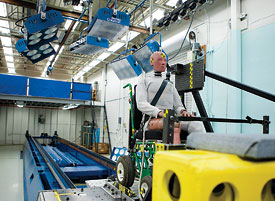There’s something curiously morbid about crash test dummies. They have an unnerving combination of lifeless and life-like features.
They even wear shoes in the sled lab at the U-M Transportation Research Institute — brown oxfords for the mid-sized male model on deck for a head-on collision at 30-mph.

A mid-sized male crash test dummy awaits a test in the U-M Transportation Research Institute’s sled lab. Photo by Laura Rudich.
“We want the tests to be as realistic as possible,” explains Matt Reed, research associate professor at UMTRI and in industrial and operations engineering.
But there’s only so much Reed and his colleagues in the field can do right now. The federal government tests crash protection for adults with just two dummy sizes, an average man and a small woman. Many people don’t fall into one of these categories. So Reed is working to get a more accurate picture of American drivers and passengers.
Right now, he’s studying older drivers. He has found that they tend to fare worse than younger people in crashes of the same severity. A lot of factors are likely to blame, Reed acknowledges, but he’s zooming in on a couple that might be easier to affect — seatbelt fit and driver posture. His team also is measuring body shape with a special 3-D scanner. Reed says there’s never been a systematic study like this. All summer he and his team, which includes eight engineering undergrads, are measuring people.
They’re aiming to bring 180 volunteers in, two-thirds of which will be over 65. Test subjects buckle up in a mock driver’s seat and researchers plot the location of 60 different points on their bodies. Then the Spandex-clad subjects stand and sit in a laser scanner that gathers 500,000 data points in five seconds.
On a recent afternoon, 70-year-old Stewart Simonett stood with his limbs in a cartwheel wind-up arrangement that the researchers call T-pose.
“Didn’t DaVinci paint something like this?” he asked. Simonett, a technician in the sled lab, was kind enough to model the research process for us. I asked him if he felt any different driving today than he did years ago. He said he didn’t.
“Even if there has been a change, it would have happened so slowly I wouldn’t have noticed,” Simonett said.
That’s probably the case with a lot of older drivers. And yet researchers like Reed have noted more injuries in crashes. These new measurements may help to explain why.
The new data could lead to a new and more varied generation of dummies. More likely, it will improve computer models so they can run more realistic crash simulations.
“Ultimately, our work is about making vehicle occupants safer,” Reed says. “As we try to make vehicles more sustainable, we make them smaller, and it’s harder to protect the occupants under those circumstances.”

